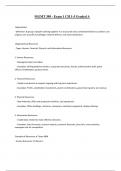MGMT 309 - Exam 1 CH 1-5 Graded A
Organization
- Definition: A group of people working together in a structured and coordinated fashion to achieve a set
of goals such as profit, knowledge, national defense, and social satisfaction.
Organizational Resources
- Types: Human, Financial, Physical, and Informative Resources.
1. Human Resources:
- Managerial talent and labor.
- Examples: Drilling platform workers, corporate executives, faculty, administrative staff, police
officers, bookkeepers, grocery clerks.
2. Financial Resources:
- Capital investments to support ongoing and long-term operations.
- Examples: Profits, stockholder investments, alumni contributions, government grants, tax revenue.
3. Physical Resources:
- Raw materials, office and production facilities, and equipment.
- Examples: Office buildings, refineries, computers, sanitation equipment, display shelving.
4. Informative Resources:
- Usable data needed to make effective decisions.
- Examples: Sales forecasts, research reports, economic forecasts, price lists, crime statistics,
newspaper ads for competitors.
Example of Resources at Texas A&M
- Human Resources: Professors.
,- Financial Resources: Tuition.
- Physical Resources: Classroom.
- Informative Resources: College Station property tax reports.
Management
- Definition: A set of activities (planning, decision making, organizing, leading, and controlling) directed
at an organization's resources to achieve goals efficiently and effectively.
The Management Process
- Flow:
- Inputs: (Human, Financial, Physical, and Informational Resources)
- Management Activities: (Planning and Decision Making, Organizing, Leading, and Controlling)
- Outputs: (Goals attained efficiently and effectively).
Management Activities
1. Planning and Decision Making: Setting organizational goals and determining how to achieve them.
2. Organizing: Grouping activities and resources effectively.
3. Leading: Motivating organization members to work in alignment with the organization’s goals.
4. Controlling: Monitoring and correcting activities to ensure goal attainment.
Basic Purpose of Management
- Efficiently and effectively using resources and making the right decisions.
What is a Manager?
- A person responsible for executing the management process.
Video Example
- Peter from "Office Space": Represents disengaged employees; highlights the importance of
performance evaluation as a management control mechanism.
, Kinds of Managers
1. By Level:
- Top Managers: Set goals and overall strategies (e.g., President, CEO).
- Middle Managers: Implement policies and supervise lower-level managers (e.g., Plant Manager).
- First-Line Managers: Oversee operational employees (e.g., Supervisor).
2. By Area:
- Marketing Managers: Focus on product promotion and consumer engagement.
- Financial Managers: Manage the organization’s financial resources.
- Operations Managers: Control systems that create products/services.
- Human Resource Managers: Oversee hiring, training, and employee relations.
- Administrative Managers: Generalists with oversight across functions.
Managerial Roles
1. Interpersonal Roles: Involve relationships (Figurehead, Leader, Liaison).
2. Informative Roles: Involve processing data (Monitor, Disseminator, Spokesperson).
3. Decisional Roles: Involve decision-making (Entrepreneur, Disturbance Handler, Resource Allocator,
Negotiator).
Managerial Skills
1. Technical: Specialized knowledge of specific work.
2. Interpersonal: Communication and motivation skills.
3. Conceptual: Ability to see the big picture.
4. Diagnostic: Problem identification and analysis.
5. Communication: Effective exchange of ideas and information.
6. Decision-Making: Recognizing problems and selecting appropriate actions.
7. Time Management: Prioritizing tasks and delegating effectively.




